Natal Main Line
| Natal Main Line | ||||||||||||||||||||||||||||||||||||||||||||||||||||||||||||||||||||||||||||||||||||||||||||||||||||||||||||||||||||||||||||||||||||||||||||||||||||||||||||||||||||||||||||||||||||||||||||||||||||||||||||||||||||||||||||||||||||||||||||||||||||||||||||||||||||||||||||||||||||||||||||||||||||||||||||||||||||||||||||||||||||||||||||||||||||||||||||||||||||||||||||||||||||||||||||||||||||||||||||||||||||||||||||||||||||||||||||||||||||||||||||||||||||||||||||||||||||||||||||||||||||||||||||||||||||||||||||||||||||||||||||||||||||||||||||||||||||||||||||||||||||||||||||||||||||||||||||||||||||||||||||||||||||||||||||||||||||||||||||||||||||||||||||||||||||||||||||||||||||||||||||||||||||||||||||||||||||||||||||||||||||||||||||||||||||||||||||||||||||||||||||||||||||||||||||||||||||||||||||||||||||||||||||||||||||||||||||||||||||||||||||||||||||||||||||||||||||||||||||||||||||||||||||||||||||||||||||||||||||||||||||||||||||||||||||||||||||||||||||||||||
|---|---|---|---|---|---|---|---|---|---|---|---|---|---|---|---|---|---|---|---|---|---|---|---|---|---|---|---|---|---|---|---|---|---|---|---|---|---|---|---|---|---|---|---|---|---|---|---|---|---|---|---|---|---|---|---|---|---|---|---|---|---|---|---|---|---|---|---|---|---|---|---|---|---|---|---|---|---|---|---|---|---|---|---|---|---|---|---|---|---|---|---|---|---|---|---|---|---|---|---|---|---|---|---|---|---|---|---|---|---|---|---|---|---|---|---|---|---|---|---|---|---|---|---|---|---|---|---|---|---|---|---|---|---|---|---|---|---|---|---|---|---|---|---|---|---|---|---|---|---|---|---|---|---|---|---|---|---|---|---|---|---|---|---|---|---|---|---|---|---|---|---|---|---|---|---|---|---|---|---|---|---|---|---|---|---|---|---|---|---|---|---|---|---|---|---|---|---|---|---|---|---|---|---|---|---|---|---|---|---|---|---|---|---|---|---|---|---|---|---|---|---|---|---|---|---|---|---|---|---|---|---|---|---|---|---|---|---|---|---|---|---|---|---|---|---|---|---|---|---|---|---|---|---|---|---|---|---|---|---|---|---|---|---|---|---|---|---|---|---|---|---|---|---|---|---|---|---|---|---|---|---|---|---|---|---|---|---|---|---|---|---|---|---|---|---|---|---|---|---|---|---|---|---|---|---|---|---|---|---|---|---|---|---|---|---|---|---|---|---|---|---|---|---|---|---|---|---|---|---|---|---|---|---|---|---|---|---|---|---|---|---|---|---|---|---|---|---|---|---|---|---|---|---|---|---|---|---|---|---|---|---|---|---|---|---|---|---|---|---|---|---|---|---|---|---|---|---|---|---|---|---|---|---|---|---|---|---|---|---|---|---|---|---|---|---|---|---|---|---|---|---|---|---|---|---|---|---|---|---|---|---|---|---|---|---|---|---|---|---|---|---|---|---|---|---|---|---|---|---|---|---|---|---|---|---|---|---|---|---|---|---|---|---|---|---|---|---|---|---|---|---|---|---|---|---|---|---|---|---|---|---|---|---|---|---|---|---|---|---|---|---|---|---|---|---|---|---|---|---|---|---|---|---|---|---|---|---|---|---|---|---|---|---|---|---|---|---|---|---|---|---|---|---|---|---|---|---|---|---|---|---|---|---|---|---|---|---|---|---|---|---|---|---|---|---|---|---|---|---|---|---|---|---|---|---|---|---|---|---|---|---|---|---|---|---|---|---|---|---|---|---|---|---|---|---|---|---|---|---|---|---|---|---|---|---|---|---|---|---|---|---|---|---|---|---|---|---|---|---|---|---|---|---|---|---|---|---|---|---|---|---|---|---|---|---|---|---|---|---|---|---|---|---|---|---|---|---|---|---|---|---|---|---|---|---|---|---|---|---|---|---|---|---|---|---|---|---|---|---|---|---|---|---|---|---|---|---|---|---|---|---|---|---|---|---|---|---|---|---|---|---|---|---|---|---|---|---|---|---|---|---|---|---|---|---|---|---|---|---|---|---|---|---|---|---|---|---|---|---|---|---|---|---|---|---|---|---|---|---|---|---|---|---|---|---|---|---|---|---|---|---|---|---|---|---|---|---|---|---|---|---|---|---|---|---|---|---|---|---|---|---|---|---|---|---|---|---|---|---|---|---|---|---|---|---|---|---|---|---|---|---|---|---|---|---|---|---|---|---|---|---|---|---|---|---|---|---|---|---|---|---|---|---|---|---|---|---|---|---|---|---|---|---|---|---|---|---|---|---|---|---|---|---|---|---|---|---|---|---|---|---|---|---|---|---|---|---|---|---|---|---|---|---|---|---|---|---|---|---|---|---|---|---|---|---|---|---|---|---|---|---|---|---|---|---|---|---|---|---|---|---|---|---|---|---|---|---|---|---|---|---|---|---|---|---|---|---|---|---|---|---|---|---|---|---|---|---|---|---|---|---|---|---|---|---|---|---|---|---|---|---|---|---|---|---|---|---|---|---|---|---|---|---|---|---|---|---|---|---|---|---|---|---|---|---|---|---|---|---|---|---|---|---|---|---|---|---|---|---|---|---|---|---|---|---|---|---|---|---|---|---|---|---|---|---|---|---|---|---|---|---|---|---|---|---|---|---|---|---|---|---|---|---|---|---|---|---|---|---|---|---|---|---|---|---|---|---|---|---|---|---|---|
|
Profile of the Natal Main Line in 1910
| ||||||||||||||||||||||||||||||||||||||||||||||||||||||||||||||||||||||||||||||||||||||||||||||||||||||||||||||||||||||||||||||||||||||||||||||||||||||||||||||||||||||||||||||||||||||||||||||||||||||||||||||||||||||||||||||||||||||||||||||||||||||||||||||||||||||||||||||||||||||||||||||||||||||||||||||||||||||||||||||||||||||||||||||||||||||||||||||||||||||||||||||||||||||||||||||||||||||||||||||||||||||||||||||||||||||||||||||||||||||||||||||||||||||||||||||||||||||||||||||||||||||||||||||||||||||||||||||||||||||||||||||||||||||||||||||||||||||||||||||||||||||||||||||||||||||||||||||||||||||||||||||||||||||||||||||||||||||||||||||||||||||||||||||||||||||||||||||||||||||||||||||||||||||||||||||||||||||||||||||||||||||||||||||||||||||||||||||||||||||||||||||||||||||||||||||||||||||||||||||||||||||||||||||||||||||||||||||||||||||||||||||||||||||||||||||||||||||||||||||||||||||||||||||||||||||||||||||||||||||||||||||||||||||||||||||||||||||||||||||||||
|
Route of the Natal Mail Line on a map from 1910
| ||||||||||||||||||||||||||||||||||||||||||||||||||||||||||||||||||||||||||||||||||||||||||||||||||||||||||||||||||||||||||||||||||||||||||||||||||||||||||||||||||||||||||||||||||||||||||||||||||||||||||||||||||||||||||||||||||||||||||||||||||||||||||||||||||||||||||||||||||||||||||||||||||||||||||||||||||||||||||||||||||||||||||||||||||||||||||||||||||||||||||||||||||||||||||||||||||||||||||||||||||||||||||||||||||||||||||||||||||||||||||||||||||||||||||||||||||||||||||||||||||||||||||||||||||||||||||||||||||||||||||||||||||||||||||||||||||||||||||||||||||||||||||||||||||||||||||||||||||||||||||||||||||||||||||||||||||||||||||||||||||||||||||||||||||||||||||||||||||||||||||||||||||||||||||||||||||||||||||||||||||||||||||||||||||||||||||||||||||||||||||||||||||||||||||||||||||||||||||||||||||||||||||||||||||||||||||||||||||||||||||||||||||||||||||||||||||||||||||||||||||||||||||||||||||||||||||||||||||||||||||||||||||||||||||||||||||||||||||||||||||
| Route length: | 1911: 495 km 2016: 460 km |
|||||||||||||||||||||||||||||||||||||||||||||||||||||||||||||||||||||||||||||||||||||||||||||||||||||||||||||||||||||||||||||||||||||||||||||||||||||||||||||||||||||||||||||||||||||||||||||||||||||||||||||||||||||||||||||||||||||||||||||||||||||||||||||||||||||||||||||||||||||||||||||||||||||||||||||||||||||||||||||||||||||||||||||||||||||||||||||||||||||||||||||||||||||||||||||||||||||||||||||||||||||||||||||||||||||||||||||||||||||||||||||||||||||||||||||||||||||||||||||||||||||||||||||||||||||||||||||||||||||||||||||||||||||||||||||||||||||||||||||||||||||||||||||||||||||||||||||||||||||||||||||||||||||||||||||||||||||||||||||||||||||||||||||||||||||||||||||||||||||||||||||||||||||||||||||||||||||||||||||||||||||||||||||||||||||||||||||||||||||||||||||||||||||||||||||||||||||||||||||||||||||||||||||||||||||||||||||||||||||||||||||||||||||||||||||||||||||||||||||||||||||||||||||||||||||||||||||||||||||||||||||||||||||||||||||||||||||||||||||||||
| Gauge : | 1067 mm ( cape track ) | |||||||||||||||||||||||||||||||||||||||||||||||||||||||||||||||||||||||||||||||||||||||||||||||||||||||||||||||||||||||||||||||||||||||||||||||||||||||||||||||||||||||||||||||||||||||||||||||||||||||||||||||||||||||||||||||||||||||||||||||||||||||||||||||||||||||||||||||||||||||||||||||||||||||||||||||||||||||||||||||||||||||||||||||||||||||||||||||||||||||||||||||||||||||||||||||||||||||||||||||||||||||||||||||||||||||||||||||||||||||||||||||||||||||||||||||||||||||||||||||||||||||||||||||||||||||||||||||||||||||||||||||||||||||||||||||||||||||||||||||||||||||||||||||||||||||||||||||||||||||||||||||||||||||||||||||||||||||||||||||||||||||||||||||||||||||||||||||||||||||||||||||||||||||||||||||||||||||||||||||||||||||||||||||||||||||||||||||||||||||||||||||||||||||||||||||||||||||||||||||||||||||||||||||||||||||||||||||||||||||||||||||||||||||||||||||||||||||||||||||||||||||||||||||||||||||||||||||||||||||||||||||||||||||||||||||||||||||||||||||||
| Maximum slope : | old route: 33 ‰ from 1965: 14.3 ‰ |
|||||||||||||||||||||||||||||||||||||||||||||||||||||||||||||||||||||||||||||||||||||||||||||||||||||||||||||||||||||||||||||||||||||||||||||||||||||||||||||||||||||||||||||||||||||||||||||||||||||||||||||||||||||||||||||||||||||||||||||||||||||||||||||||||||||||||||||||||||||||||||||||||||||||||||||||||||||||||||||||||||||||||||||||||||||||||||||||||||||||||||||||||||||||||||||||||||||||||||||||||||||||||||||||||||||||||||||||||||||||||||||||||||||||||||||||||||||||||||||||||||||||||||||||||||||||||||||||||||||||||||||||||||||||||||||||||||||||||||||||||||||||||||||||||||||||||||||||||||||||||||||||||||||||||||||||||||||||||||||||||||||||||||||||||||||||||||||||||||||||||||||||||||||||||||||||||||||||||||||||||||||||||||||||||||||||||||||||||||||||||||||||||||||||||||||||||||||||||||||||||||||||||||||||||||||||||||||||||||||||||||||||||||||||||||||||||||||||||||||||||||||||||||||||||||||||||||||||||||||||||||||||||||||||||||||||||||||||||||||||||
| Minimum radius : | old route: 300 ft / 91 m from 1965: 219 m |
|||||||||||||||||||||||||||||||||||||||||||||||||||||||||||||||||||||||||||||||||||||||||||||||||||||||||||||||||||||||||||||||||||||||||||||||||||||||||||||||||||||||||||||||||||||||||||||||||||||||||||||||||||||||||||||||||||||||||||||||||||||||||||||||||||||||||||||||||||||||||||||||||||||||||||||||||||||||||||||||||||||||||||||||||||||||||||||||||||||||||||||||||||||||||||||||||||||||||||||||||||||||||||||||||||||||||||||||||||||||||||||||||||||||||||||||||||||||||||||||||||||||||||||||||||||||||||||||||||||||||||||||||||||||||||||||||||||||||||||||||||||||||||||||||||||||||||||||||||||||||||||||||||||||||||||||||||||||||||||||||||||||||||||||||||||||||||||||||||||||||||||||||||||||||||||||||||||||||||||||||||||||||||||||||||||||||||||||||||||||||||||||||||||||||||||||||||||||||||||||||||||||||||||||||||||||||||||||||||||||||||||||||||||||||||||||||||||||||||||||||||||||||||||||||||||||||||||||||||||||||||||||||||||||||||||||||||||||||||||||||
|
||||||||||||||||||||||||||||||||||||||||||||||||||||||||||||||||||||||||||||||||||||||||||||||||||||||||||||||||||||||||||||||||||||||||||||||||||||||||||||||||||||||||||||||||||||||||||||||||||||||||||||||||||||||||||||||||||||||||||||||||||||||||||||||||||||||||||||||||||||||||||||||||||||||||||||||||||||||||||||||||||||||||||||||||||||||||||||||||||||||||||||||||||||||||||||||||||||||||||||||||||||||||||||||||||||||||||||||||||||||||||||||||||||||||||||||||||||||||||||||||||||||||||||||||||||||||||||||||||||||||||||||||||||||||||||||||||||||||||||||||||||||||||||||||||||||||||||||||||||||||||||||||||||||||||||||||||||||||||||||||||||||||||||||||||||||||||||||||||||||||||||||||||||||||||||||||||||||||||||||||||||||||||||||||||||||||||||||||||||||||||||||||||||||||||||||||||||||||||||||||||||||||||||||||||||||||||||||||||||||||||||||||||||||||||||||||||||||||||||||||||||||||||||||||||||||||||||||||||||||||||||||||||||||||||||||||||||||||||||||||||
The Natal Main Line , German " Natal Main Line " is a railway line in South Africa , which connects Durban with Volksrust and is part of the Durban – Johannesburg rail link . Sometimes the term Natal Main Line is used for the whole route to Johannesburg or the last station in the former British colony of Natal Charlestown is named as the terminus of the route. The branch from Ladysmith to Harrisimth in the former Orange Free State is also often included.
The route was built by Natal Government Railways and opened continuously in 1891. Some of the mountain railway sections of the route were partially re-routed several times. The Natal Main Line was completely converted to electrical operation in 1937 and was then the longest electrically operated railway in the British colonial empire .
history

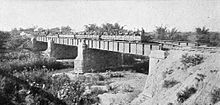

In 1875 the Natal Government Railway Act was passed, which founded the NGR and decided to build a railway line from Durban to Pietermaritzburg , as well as two branch lines to Verulam and Isipingo . Due to the difficult terrain through which the line was to lead inland, it was decided to build the lines in Cape Gauge , the gauge of which is 1067 mm. It was also determined that 21 foot long rails weighing 40 pounds per yard should be used and laid on at least 2000 creosote treated sleepers per mile . The minimum turn radius was set at 300 feet and the maximum slope at 1:30. In metric units, this results in a superstructure on 6.4 m long 20 kg / m rails with 1240 sleepers per kilometer on a route with a minimum curve radius of 90 m and gradients no greater than 33 ‰. For the route to Pietermaritzburg a cost of 606,749 pounds or the equivalent of 7,778 pounds per mile was calculated.
Railway construction began in Durban in 1876. The line reached Pietermaritzburg in 1880 , Ladysmith in 1886 and Charlestown in 1891 on the border of the colony with the Transvaal Republic . In 1896 the continuous operation to Johannesburg could be opened.
Durban – Pietermaritzburg
The construction of the railway to Pietermaritzburg officially began on New Year's Day in 1876 with the groundbreaking ceremony by Sir Henry Bulwer , then Vice-Governor of the Natal Colony, although the contracts for work with the contractors Wythes & Jackson , who were already involved in the construction of the Great Indian Peninsula Railway, were only signed in February. On April 1st of the same year the first 100 railway construction workers from Mauritius arrived in Durban. The construction company was obliged to recruit at least two thirds of the workforce outside the colony to prevent agriculture from suffering from the railway construction. At the end of June 1876, the earthworks for four miles of the route were completed and the foundation work for the bridge over the Umbilo was carried out. At the same time, construction work began in Pietermaritzburg, where the future terminus at the foot of Camp Hills to the future bridge over the Umsindusi began.
On January 1, 1877, the NGR took over the Natal Railway , which from 1860 operated a standard-gauge railway line between Point near the harbor and the city center of Durban. A new track bed for the Cape gauge line was laid along the existing line, which was completed in February 1877 and on which the first locomotives for the construction companies were soon running.
In February 1878 the bridge over the Umbilo River near Pinetown was completed and in Durban goods traffic was started on the Cape Gauge route along the standard gauge route of the former Natal Railway from Point to Market Square Station, passenger traffic remained on the standard gauge route until May . In September operations to Pinetown began with two pairs of trains, which were soon followed by a third following complaints from the population.
With the start of the Zulu War in January 1879, military transports had priority on the railroad, so that only little material reached the construction sites. Nevertheless, the route to Botha's Hill could be opened in March , until June only 1st and 2nd class travelers and military goods were transported. Only then was the railway approved for wool , hides and colonial goods .
The earthworks between Botha Hill and Inchanga were difficult, especially since there were no suitable quarries . It was therefore decided not to build the larger bridges in masonry, but as steel truss bridges. Of the nine bridges to be built, the largest was a seven-span 27 m high and 173 m long trestle bridge in front of Wallacetown station. In order to avoid further delays in laying the tracks to Pietermaritzburg, the construction companies transported the rails and a small locomotive over the main road to the construction site at Camperdown . Camperdown was reached on October 1, 1880, and the Pietermaritzburg marshalling yard on October 21. The official opening was scheduled for November 15, but could not take place as planned because at the beginning of the month rain set in, which caused several derailments due to subsidence and washout. The line had to be repaired before it was officially opened on December 1st.
After the opening of the route to Pietermaritzburg, the construction company Wythes & Jackson brought in a demand for about a quarter of the total order volume in July 1881 for various reasons. The most important points were the shortage of manpower, which the government of Natal would not have taken care of, the land made available too late by the government for the construction of the railway and additional expenses for the construction of bridges due to demands of the engineer supervising the construction. The government countered the additional demands of the construction company that the railway had been completed eight months too late and that in many places the poor quality ballast would have had to be replaced after just a few years of operation. The blame for these additional claims was put on the Crown Agent , the representative of the British monarchy , who should have supervised the awarding of the contract and processing. An arbitration tribunal decided in 1884 that only a small part of the construction company's claims had to be met, namely compensation for the land that was made available too late and the Natal Railway, which was converted too late to Cape gauge.
In mid-1883, serious structural defects were found on the bridges at Inchanga because the foundations of the piers had partially slipped. In the Inchanga Viaduct, there were vibrations from the wind and lateral forces from the arches in the access to the viaduct. In strong winds, the passenger trains were stopped so that the passengers could disembark and the empty train could drive alone over the bridge. The passengers followed the empty train across the bridge on foot.
Pietermaritzburg – Ladysmith
Although the construction of the railway to Pietermaritzburg was a great challenge for the colony and at times brought it close to the financial abyss, the line was to be extended further to Ladysmith , where the trade routes from the Transvaal and the Orange Free State towards Durban come together. In addition, a transport route to the port for the coal deposits in the interior should be provided. The construction of the railway was supposed to help direct the flow of goods via the port of Durban and to anticipate other projects to develop the region of Johannesburg, in particular the railway line through the Orange Free State to Cape Town and the Delagoa railway to Lourenço Marques, today's Maputo in Mozambique . The building contract was signed in April 1882 with the entrepreneur James Perry. On July 1, 1884, the line to Howick , December 21, 1885 to Estcourt and June 21, 1886 to Ladysmith was opened.
Ladysmith – Volksrust / Harrismith
The extension beyond Ladysmith was a long time coming. Orange Free State, Transvaal and Natal first had to clarify how goods from and for the states in the interior of the country are to be handled in terms of customs when they are transported through Natal via the port of Durban. In particular, the Orange Free State wanted to have part of the taxes levied in Durban. On the other hand, the coal deposits at Glencoe should finally be tapped by rail so that this coal could be used to fire the company's own locomotives, but also to coal the ships in the port of Durban. Time was of the essence for Natal, if the colony wanted to participate in the flow of goods triggered by the economic boom in Johannesburg after the discovery of gold in 1886. A noticeable increase in transport volume was already noticeable on the existing route, which brought the initially deficit rail operations into the black.
After lengthy political discussions and after the economy had recovered from a crisis, it was decided in 1888 to continue the railway construction from Ladysmith both to Van Reenen's Pass on the border with the Orange Free State and towards the border with the Transvaal. In contrast to the previous sections, the work was not outsourced to a general contractor, but rather to smaller companies in individual sections.
The construction of the railway to develop the coal mine near ElandslaAGEN was approved as early as 1887. Construction of the railway began in the same year, so that the line could already be used for coal transport from July 1888. In September 1889 Glencoe was reached and in March 1890 the branch line to Dundee was completed. From November 1890 the trains ran to Newcastle and in April 1891 Charlestown (Kwazulu-Natal) was reached. In October of the same year, the 675 m long tunnel at Langs Nek was put into operation, which made two provisionally built switchbacks unnecessary.
Construction towards Van Reenen's Pass began in November 1889; Van Reenen was reached in August 1891; on July 13, 1892, Harrismith was reached.
Continuation to Johannesburg
The Natal railway was supposed to provide a connection to Johannesburg in order to be able to direct the traffic flows from the gold fields via Durban. At the same time, however, the Transvaal did everything in its power to ensure that its own Delagoa railway should be completed before the other railway lines from the Johannesburg area to the coast. Due to the lack of funds in the Transvaal this did not succeed, so that the line to Cape Town went into operation as the first connection to a seaport in September 1892 and the Delagoa Railway in 1895 and only a year later on January 2, 1886 the extension of the Natal Main Line could go into operation beyond Volksrust to Johannesburg. The line was built by the Natal Government Railway to Volksrust, the rest of the line via Standerton and Heidelberg in the Johannesburg area by the Nederlandsch-Zuid-Afrikaansche Spoorwegmaatschappij (NZASM). The line from Natal joins the Cape Government Railway (CGR) line from Cape Town to Johannesburg Park Station near Elsburg .
When the direct connection between Durban and Johannesburg opened, the trains needed 27 hours and 45 minutes for the 776 km long route. On the old sections with 20 kg / m rails, trains were allowed to run at 24 km / h, on those with 22 kg / m or 30 kg / m rails, freight trains were allowed to travel at 30 km / h and passenger trains at 37 km / h. h drive.
Expansion of the route
The originally 489 km long route from Durban to Charlestown from 1886 had gradients of 17 to 25 ‰ over 346 km and gradients of up to 33 ‰ over 64 km. With the 91 m bends arranged in the steepest sections, the result was a driving resistance that corresponded to a slope of 41 ‰ in a straight section.
At the beginning of the 20th century, the traffic increased so much that a completely new route was sought between Biggarsberg and Durban, which should get along with 152 m bends and 20 ‰. Two variants of re-routing with several engineering structures about 50 km northeast of the existing route were worked out between Durban and Wesselnek, which were discarded again in 1903. Instead, the existing line was upgraded to the new standard until the 1920s, and additional crossing stations were built along the entire Natal Main Line.
The old route, which had almost no engineering structures, but narrow radii and steep inclines, was gradually replaced by a new route with tunnels and bridges, which could be created with larger radii and smaller inclines.
In 1879 the staff and ticket system was introduced on the route . From 1897 the Webb & Thompson Electric Train Staff was gradually introduced until the line was equipped with this system throughout in 1903.
The chronology of the route expansion is shown in the following table.
| Work | graduation | comment |
|---|---|---|
| Removal of the Inchanga viaduct and the new Inchanga station | April 24, 1892 | first route relocation |
| Double lane Durban – Umbilo | June 25, 1899 | first double track expansion |
| Double lane Umbilo – South Coast Junction with a new bridge over the Umbilo River | March 26, 1900 | |
| War damage from the first Boer War eliminated | June 18, 1900 | The Natal Government Railway was affected by the fighting from October 11, 1899. |
| Replacement of the superstructure of the entire route with 39 kg / m rails, reinforcement of bridges | December 8, 1901 | |
| Five additional crossing stations between Estcourt and Mooi River | 1902 | |
| New routes at Harts Hill, Willowford and Frere | 1905 | |
| New route between Umsindusi and Pietermaritzburg | July 8, 1906 | |
| New route South Coast Junction – Sea View to bypass Jacob's Ladder | April 21, 1907 | |
| New route between Sea View and Bellair | January 5, 1908 | |
| New route Padley – Hillcrest | December 9, 1906 | first improvement of the routing for traffic towards Durban |
|
Mooi River – Estcourt Deviation
New route with two tunnels. |
September 7, 1914 | First expansion under South African Railways. The slope on this section is reduced from 33 ‰ to 15 ‰ |
|
Town Hill Deviation
New route Pietermaritzburg – Cedara with two 180 ° loops |
December 6, 1916 | |
| Umlaas Road – Pentrich Deviation | May 11, 1919 | The 31 km route moves the highest point between Durban and Pietermaritzburg down from 931 m above sea level to 800 m. |
| Double lane Umlaas Road – Cato Ridge | July 1, 1917 | |
| Booth – Cato Ridge Deviation with ten tunnels and a bridge | Late 1921 | With a length of 64 km the largest route relocation
Continuous 15 ‰ gradient |
| Cedara – Nottingham Road Deviation with two short tunnels | March 2, 1924 | |
| Van Reenen's pass route: Replacement of the three hairpin bends with a loop and a spiral tunnel at | May 18, 1925 | |
| Clearance of the Cedara tunnel | March 28, 1960 | Operation on the Town Hill Deviation section, which was opened in 1916, is being abandoned due to landslides |
| New double-lane section
Umlaas Road – Pentrich with five tunnels and a 273 m long viaduct over the Mkondeni river and a 375 m long bridge over the Mpushini river |
1965 | The distance is shortened by 10.38 km. Inland, the maximum between Durban and Pietermaritzburg is 15 ‰, in the opposite direction 5.7 ‰. Minimum curve radius: 219 m. The Umlaas Road – Pentrich Deviation from 1916 is closed. |
electrification

The incline at Mooi River was a major obstacle to transporting coal from Glencoe to Durban Harbor . The trailer load on the Ladysmith – Mooi River section was limited to 820 t during steam operation. A coal train from Glencoe to Pietermaritzburg took 16.5 hours. In order to increase the capacity of the line, it was decided in 1921 to electrify it with 3,000 V direct current and to procure 78 class 1E locomotives from Metropolitan-Vickers in Manchester , which could be used for both freight and passenger trains. They were equipped for multiple traction and had an electric brake .
The coal-fired power station Colenso was built for the electricity supply . The energy was distributed to the 12 transformer stations along the route using two 88 kV high-voltage lines .
In October 1924 the first section Chieveley – Ladysmith was put under tension, which was extended to Estcourt in December of the same year. From January 1925, 1430 t trains with three locomotives at the top ran. In May 1925 the electrical operation reached Mooi River and in July it was extended from Ladysmith to Glencoe, in October to Nottingham Road and in April 1926 to Pietermaritzburg. The first electrically guided passenger trains ran in June 1926; previously only freight trains were hauled by electric locomotives. With electric traction, a freight train from Glencoe to Pietermaritzburg only needed 10.25 hours and the number of drivers for this section could be reduced from 300 to 170 men. With the introduction of electrical operation, the rails initially broke, so that the superstructure was reinforced from 1929. Rails with a weight of 42 kg / m were laid, which allowed axle loads of 22 t.
In 1932, electrification was extended beyond Pietermaritzburg to Cato Ridge. To save money, the catenary masts were made from old rails. At the end of 1936, electrical operations on the Durban – Cato Ridge section were officially opened, and in October 1937 the remaining Glencoe – Volksrust section, so that the entire Natal Main Line was electrified.
Route description
Durban – Pietermaritzburg
From the city center of Durban, the route runs parallel to the coast and crosses the Umbilo River. After Booth, where the line branches off to the south in the direction of Port Shepstone , the Natal Main Line swings inland, where the original route from 1878 splits from that which was commissioned in 1936 and only meets again at Cato Ridge at 755 m.
The new line runs with a gradient of 15 ‰ along the Mhlatuzana River and has several tunnels, the longest are approximately one kilometer long and have a separate tube for each track of the double lane . The old route over Pinetown begins to climb at 33 ‰ and climbs the Bellair section called Jacob's Ladder (German: "Jakobs-Leiter") . Pinetown the contact line ends, the rest of the way to Cato Ridge is between Kloof and Inchanga only by the trains of the museum train Umgeni Steam Railways busy. While the new route climbs continuously, the old route has considerable counter-gradients. The lines run partly in an exposed position along steep rock faces with a view of the Valley of a Thousand Hills (German: "Valley of 1000 Hills"). Shortly after Botha's Hill the route leads through the only tunnel of this section, the 53 m long Drummond Tunnel.
After Umlaas Road, the Natal Main Line, which has been in use since 1965, reaches the highest point between Durban and Pietermaritzburg at 800 m. This is followed by a section rich in engineering structures to Pietermaritzburg, on which there are five tunnels and the 375 m long Mpushini Viaduct.
The old route from 1880 led through Thornville and reached a height of 931 m above sea level. The section between Umlaas Road and Thornville was discontinued and dismantled in 1988. The route, which was opened in 1919, ran roughly along the current route and was discontinued when it opened.
Pietermaritzburg – Ladysmith
The route leads in a westerly direction out of Pietermaritzburg and climbs steeply up the slope with a double loop to reach the southern portal of the 6 km long Cedara tunnel opened in 1960 , which was the longest railway tunnel in South Africa when it opened and only opened in 1989 Hex River Tunnel was surpassed. From the north portal at Cedara, the route leads through simpler terrain to Mooi River , where it crosses under the Hidcote Beacon with a 4 km long tunnel before it reaches Estcourt and continues to Ladysmith.
In the section between Pietermaritzburg and Cedara, the route was retraced twice. The route from 1884 initially led south around Signal Hill and over Blackridge , Sweetwaters and Hilton to Cedara. The highest point of the route was reached shortly before Hilton at 1137 m. A new route, the Town Hill Deviation , opened in 1916. She followed today's route, but left it in front of the south portal of the Cedara tunnel to the east and followed the slope around Town Hill. Hilton was driven under with a 831 m long tunnel before the route at Cedara met today's route. The Town Hill Deviation was closed and dismantled with the opening of the Cedara Tunnel, because the route was often covered by landslides. The line from 1884, on the other hand, was preserved until the 1980s, only the section south of Signal Hills was dismantled earlier. Hilton Station is operated as a small railroad museum by the Hilton Steam Heritage Association .
The route has also been retraced twice at Mooi River and Estcourt. The first time in 1914 to replace the original route without a tunnel with an almost continuous 33 ‰ gradient with a route with 15 ‰, which had two tunnels and the second time in 1957 with the construction of the Hidocte and Beacon Hill tunnels.
Ladysmith Volksrust
The route leads in a north-easterly direction out of the city, where the Danskraal marshalling yard is passed before the route branches off to Van Reenen's Pass . Outside the city, it follows the N11 for about 30 km to the coal mines of ElandslaAGEN, where it leaves the N11, runs more eastward and crosses the Sundays River . It crosses the Biggarsberg and reaches Glencoe, about 10 km west of Dundee . After Newcastle, the route has to overcome the Langsnek Pass in the Drakensberg with a difficult route . The route was changed several times at this point and initially contained four switchbacks south of the pass. Today the pass will be driven under with a 1050 m long tunnel.
The border of the former colony Natal is reached at Volksrust. The original end point of the route was at Charlestown, which is about two miles from the border. The place was re-established and is named after Charles Bullen Hugh Mitchell , the then governor of Natal.
Ladysmith-Harrismith
The Harrismith line branches off the Glencoe line approximately four kilometers outside Ladysmith. The first 44 km to Brakwal run in easy terrain, then the 300 m difference in altitude had to be overcome to Van Reenen's Pass, which initially required three switchbacks, which were later replaced by a double loop with a spiral tunnel. The rest of the way to Harrismith was easy to master again.
vehicles
Steam locomotives
The first two dainty locomotives from the railway construction companies arrived in Durban in early 1877. The tank locomotives from Beyer-Peacock from Manchester were called Pietermaritzburg and Durban , weighed 25 t and had a pulling force of 45 kN. The locomotives designed for wood firing were fired with eucalyptus . The first NGR locomotives were identical and arrived in Durban in December 1877. They came along with ten passenger coaches and 13 gondolas .
Until 1903 only tank locomotives were procured. This was followed by several tender locomotives, which were designed by the Chief Mechanical Engineer of the NGR, DA Hendrie and which bore his name. The world's first tender and tender locomotives with the Mountain wheel arrangement were in use on the Natal Main Line .
ALCO built two individual pieces for the NGR, which were to be regarded as test locomotives. These were a locomotive called American D similar to the Hendrie D and a Mallet locomotive with the wheel arrangement (1'C) C. The American D was the railway's first superheated steam locomotive , which resulted in an order for a superheated steam version of the Hendrie D, which was delivered as SAR class 3B in 1912 after the South African Railways merged by merging the lines on the soil of the still young South African Union in 1912 were.
The Mallet locomotive was successful, so that another five pieces were delivered by ALCO as Mallet MB. These locomotives were mainly used to push heavy coal trains on the section from Estcourt to Mooi River.
The last steam locomotives used in the main traffic on the Natal Main Line were SAR class 14 locomotives used in double traction and the powerful Garratt locomotives of the GL class . These were the largest steam locomotives ever built for Cape Gauge. At the beginning of the 1930s they pulled 1200 t freight trains on the Durban – Pietermaritzburg section, while the line north to Glencoe was already electrified. Until 1974, steam locomotives were in subordinate service and in front of trains that were switched to non-electrified branch lines.
Natal Government Railways
The design of the Natal Government Railways (NGR) locomotives was heavily influenced by the railroad's chief engineers. The function was taken over by William Milne in 1877 , followed by George William Reid in 1893 , followed by David Anderson Hendrie in 1903. The last two were previously employed by the Highland Railway in northern Scotland .
| designation | design type | number | Construction year | Manufacturer | image | Main
use |
|---|---|---|---|---|---|---|
| W & J construction locomotives | 1'C n2t | 2 | 1876 | Kitson |

|
Construction locomotives |
| NGR K | 1'C n2t | 7th | 1877-1878 | Beyer-Peacock |

|
all trains |
| NGR K & S | 2'C n2t | 37 | 1879-1885 | Kitson , Stephenson |

|
all trains |
| NGR Dübs A | 2'D1 'n2t | 102 | 1888-1899 | Dübs & Co |

|
all trains |
| NGR Reid ten-wheeler | 2'E1 'n2t | 101 | 1899-1903 | Neilson Reid |

|
Freight transport |
| NGR Dübs B | 2'D1 'n2t | 25th | 1904 | Dübs & Co |

|
Sliding service |
| NGR Hendrie B | 2'D n2 | 50 | 1904 | North British |

|
all trains |
| NGR Hendrie A | 2'C1 'n2 | 2 | 1905 | North British |

|
Estcourt – Volksrust passenger trains |
| NGR Hendrie B
(rebuilt) |
2'D1 'n2 | 6th | 1906 | North British |

|
first mountain locomotives in the world
Passenger trains |
| NGR Hendrie D | 2'D1 'n2 | 30th | 1909-10 | North British |
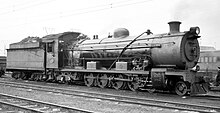
|
Coal trains in the more northerly, flatter part of the route |
| NGR American D | 2'D1 'h2 | 1 | 1909 | ALCO |

|
Heavy freight trains |
| NGR Mallet MA | (1'C) C h4 | 1 | 1909 | ALCO |

|
Heavy freight trains |
| NGR Mallet MB | (1'C) C h4 | 5 | 1910 | ALCO |

|
Coal trains on the Estcourt – Highlands ramp |
| NGR Hendrie C | 2'C1 'n2 | 2 | 1910 | NGR (Durban) |

|
South African Railways
Steam locomotives ran on the Natal Main Line until August 1974. The last types used were Garratt locomotives of the classes GF , GMAM and GCA .
| designation | design type | number | Construction year | Manufacturer | image | Main
use |
|---|---|---|---|---|---|---|
| SAR 3B | 2'D1 'h2 | 25th | 1912 | North British |

|
improved version of the Hendrie D
Coal trains in the more northerly, flatter part of the route |
| SAR MC | (1'C) C h4 | 10 | 1912 | North British | Pushing in coal trains | |
| SAR 14 | 2'D1 'h2 | 45 | 1913-1915 | Stephenson |

|
all trains |
| SAR 16 | 2'C1 'h2 | 12 | 1914 | North British |

|
|
| SAR 14B | 2'D1 'n2 | 15th | 1915 | Beyer-Peacock |

|
|
| SAR MH | (2'C1 ') (1'C2') h4 | 2 | 1927 | Maffei |

|
Heaviest locomotive for Cape gauge on delivery
Freight trains |
| SAR GA | (1'C) (C1 ') h4 | 1 | 1920 | Beyer-Peacock |

|
Freight trains |
| SAR GF | (2'C1 ') (1'C2') h4 | 65 | 1927-1928 | Hanomag , Henschel , Maffei |

|
Freight trains |
| SAR GCA | (1'C1 ') (1'C1') h4 | 39 | 1927-1928 | Croup |

|
Freight trains |
| SAR GL | (2'D1 ') (1'D2') h4 | 8th | 1929 | Beyer-Peacock |

|
Largest locomotives on Cape Gauge on delivery
Freight trains on the new Durban – Pietermaritzburg line |
| SAR GMAM | (2'D1 ') (1'D2') h4 | 120 | 1952-1958 | Henschel, Beyer-Peacock, North British |

|
74 locomotives are based in Pietermaritzburg
Used in front of freight trains on the branch lines to Franklin and Greytown |
Electric locomotives
Between 1924 and 1937 the entire Natal Main Line was converted to electrical operation. As early as 1935, the line was the longest electrically operated full-line railway in the British colonial empire.
| designation | design type | number | Construction year | Manufacturer | commitment | image |
|---|---|---|---|---|---|---|
| 1E | Bo'Bo ' | 172 | 1923-1944 | SLM , Metrovick , Werkspoor , RSH | Freight trains passenger trains |
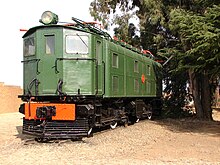
|
| IT | Bo'Bo ' | 4th | 1936-1964 | SLM , Metrovick , Werkspoor , RSH | Shunting service in Danskraal |

|
| 3E | Co'Co ' | 28 | 1947 | Metrovick , RSH | Passenger trains in the upper part of the route |

|
| 5E | Bo'Bo ' | 745 | 1954-1966 | Metrovick , UCW , English Electric , Vulcan Foundary | Freight trains passenger trains also used on other 3 kV lines |

|
| 6E1 | Bo'Bo ' | 960 | 1969-1985 | UCW, GEC | Freight trains passenger trains also used on other 3 kV lines |
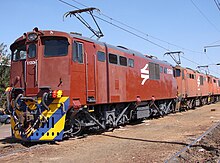
|
| 18E | Bo'Bo ' | 85 | 2000-2014 | Transnet Koedoespoort | Freight trains passenger trains also used on other 3 kV lines |
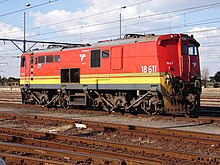
|
Multiple units
Multiple units are used in suburban traffic from Durban.
| designation | number
dare per train |
number
Single wagon |
Construction year | Manufacturer | commitment | image |
|---|---|---|---|---|---|---|
| 5M2A | 4-14 | 4447 | 1958-1985 | Metro Cammell | Suburban traffic in Durban
(not exclusively) |

|
business
history
The Natal Main Line is mainly used for freight traffic between Johannesburg and the port of Durban. After the start of continuous operations to Johannesburg, traffic increased rapidly. It served on the one hand to supply the gold fields of Witwatersrand , but also to transport coal from the north of Natal. In 1903 200,000 tons of goods were transported. The operationally most difficult section of the route is between Estcourt and Mooi River, on which the trains were hauled by two Dübs A series locomotives from 1903 .
More than half of the goods carried was coal for the port of Durban. These trains were pushed from 1906 in the direction of Durban on the sections Estcourt-Highlands, Umsindusi-Thornville and Inchanga-Alverstone. They consisted of 13 cars with a brake car and had a total weight of 442 t. The locomotive was a Hendrie B or a Reid ten-wheeler , and a Dübs B was used for the pushing service.
In order to cope with the increasing traffic without increasing the line capacity, the train length was doubled on some route sections from 1908. Operationally, two trains of normal length were coupled one behind the other, so that the locomotive of the second train became an intermediate locomotive . The process was used on several sections of the route both inland and in the direction of the port. On the Estcourt – Highlands section, the double train was pushed in, so that three working locomotives carried the train.
Current condition
Freight trains connect the Johannesburg region with the port in Durban. Mainly consumer goods and new cars are transported.
The S-Bahn trains of the Metrorail Durban run to Cato Ridge on the 1936 line, to Pinetown on the 1878 line . The Umgeni Steam Railway museum train runs between Kloof and Inchanga .
A high-speed line between Johannesburg and Durban is being considered for the future . In 2010, China Railway Group worked out a feasibility study for two variants: a pure high-speed line for speeds of up to 300 km / h or a line for high-speed trains and freight trains for a maximum speed between 180 and 200 km / h. With trains traveling at 350 km / h, travel time could be shortened from six to three hours.
literature
- Heinie Heydenrych, Bruno Martin: The Natal Main Line Story . HSRC Publishers, 1992, ISBN 978-0-7969-1151-3 .
Web links
Individual evidence
- ^ Bruno Martin: Durban-Pietermaritzburg. (PDF) September 2005, accessed on March 9, 2016 (English).
- ^ Jim Fergusson: South Africa (Natal) Railways - Passenger Stations & Stops. (PDF) March 14, 2014, accessed on March 9, 2016 (English).
- ↑ Open Street Map. Retrieved March 9, 2016 .
- ^ A b South African Electrification. In: Mike's Railway History. Retrieved March 15, 2016 .
- ^ Michael Cottrell: The first public railway in South Africa: The Point to Durban railway of 1860 . In: Natal Society Foundation (ed.): Natalia . No. 40 , 2010, p. 20–31 ( natalia.org.za [PDF]).
- ↑ a b c d e f g Bruno Martin: The Opening of the Railway between Durban and Pietermaritzburg . Ed .: Natal Society Foundation. No. 10 , 1980, pp. 34–40 ( natalia.org.za [PDF; accessed March 15, 2016]).
- ↑ a b Heinie Heydenrych, Bruno Martin: The Natal Main Line story . HSRC Publishers, 1992, ISBN 978-0-7969-1151-3 .
- ^ Hilton Steam Heritage Association (HSHA). In: HiltonVillage.co.za. Retrieved March 26, 2016 .
- ^ Mike Cottrell: History of the Old and New Main Lines. (No longer available online.) In: Umgeni Steam Railway. Archived from the original on March 2, 2016 ; accessed on March 28, 2016 (English). Info: The archive link was inserted automatically and has not yet been checked. Please check the original and archive link according to the instructions and then remove this notice.
- ^ Crown Publications: High-speed train from Jhb to Dbn? It's coming ... Retrieved September 3, 2016 .
- ^ Durban speed train on track. IOL, accessed September 3, 2016 .






